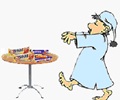Researchers at Johns Hopkins University have found that symptoms in patients with obstructive sleep apnea and hypopnea can be significantly reduced through treatment.
Researchers at Johns Hopkins University have found that symptoms in patients with obstructive sleep apnea and hypopnea can be significantly reduced through treatment with nasal insufflation (TNI), using a nasal cannula to deliver warm, humidified air at a high flow rate.
“Our findings provide evidence that TNI may offer a viable treatment alternative to patients with obstructive hypopneas and apneas,” said lead researcher Hartmut Schneider, M.D., of Johns Hopkins Asthma and Allergy Center.The research was reported in the second issue for July 2007 of the American Journal of Respiratory and Critical Care Medicine published by the American Thoracic Society.
The proof of concept study included 11 patients with mild to severe apnea-hypopnea disorders, who were selected to provide a balanced range of disease severity. Apnea was defined as complete cessation of airflow for more than 10 seconds. Hypopnea was defined as a greater than 30 percent reduction of airflow.
After baseline data were established for each patient while undergoing TNI at 0, 10 and 20L/minute, subjects were randomized to receive either no treatment or treatment with TNI at 20L/minute on separate nights. Researchers then measured airflow and superglottic pressure and monitored body position, sleep arousals and respiratory events.
At TNI of 10L/minute, some indications of disordered breathing showed improvement, but airflow limitations and snoring persisted. However, at TNI of 20L/minute, all patients showed a marked improvement. “When TNI was administered, sleep and breathing patterns stabilized,” said Dr. Schneider.
Furthermore, the results showed that even patients with more severe disorders gained significantly from TNI. “Although we expected marked improvements in the apnea-plus-hypopnea index (AHI) primarily in patients with hypopneas rather than obstructive apneas, TNI lowered the AHI in all subjects,” the researchers wrote.
Advertisement
“Improved therapeutic strategies are required to treat sleep apneas and hypopneas and their associated morbidity and mortality.” Sleep apnea affects more than 12 million Americans, according to the National Institutes of Health, and is especially prevalent in overweight or obese individuals. Many more have the milder form of sleep-associated respiratory disorders, hypopnea.
Advertisement
“At present, CPAP [continuous positive airway pressure] is most effective at eliminating apneas and hypopneas, [but] long-term effectiveness is compromised by low adherence,” wrote the researchers.
“We developed a simplified method for increasing pharyngeal pressure by delivering warm and humidified air at a continuous high flow rate through the open nasal cannula.”
While patients with severe sleep apneas may be more highly motivated to adhere to treatment with CPAP or surgery, younger, thinner and healthier patients with milder disorders may find the TNI approach appealing, according to Dr. Safwan Badr, chief of pulmonary, critical care and sleep medicine at Haper University Hospital in Detroit and chair of the American Thoracic Society’s Assembly on Respiratory Neurobiology and Sleep.
The authors noted that the minimally intrusive nasal interface of TNI may improve patient adherence, and may ultimately prove more effective at managing long-term morbidity and mortality of sleep apnea.”
Furthermore, the fact that one flow rate and one cannula size were sufficient to stabilize breathing patterns in the majority of subjects suggests that titration of TNI may be unnecessary, streamlining the initiation of treatment.
The present study is a proof of concept, the authors wrote, and will require replication in clinical trials. However, the study represents the first step in developing a new potential alternative to current sleep apnea treatments that may lower the barrier for care in patients with sleep-associated breathing disorders.
Source-Eurekalert
JAY/M











